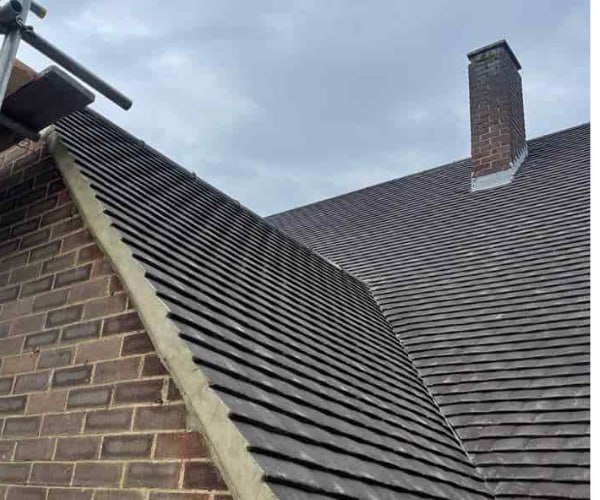How to Inspect Your Flat Roof for Damage
Introduction: Flat roofs are a practical choice for many properties, offering modern aesthetics and efficient space utilisation. However, their flat design can make them more prone to water pooling and other issues if not properly maintained. Regular inspections are crucial to ensure your flat roof remains in good condition and to catch any potential problems early. At BMT Roofing Wollaston, we provide expert advice to help you keep your flat roof in top shape. Here’s a step-by-step guide on effectively inspecting your flat roof for damage.
1. Safety First
Why It Matters: Safety is paramount when inspecting your roof. Flat roofs can still pose risks, and taking precautions is essential to avoid accidents.
How to Do It:
- Use Proper Equipment: Wear non-slip shoes, and consider using a safety harness if you need to work at height.
- Use a Ladder Safely: Ensure your ladder is stable and positioned correctly. Have someone assist you while you inspect the roof.
Tip: If you’re uncomfortable with heights or unsure of safety procedures, consider hiring a professional to conduct the inspection.
2. Visual Inspection
Why It Matters: A visual inspection is often the first step in identifying potential issues with your flat roof. Regular checks can help you spot problems before they escalate.
How to Do It:
- Check for Visible Damage: Look for cracks, blisters, and tears in the roofing material. Pay attention to areas around roof penetrations, such as vents and chimneys.
- Inspect for Water Damage: Look for signs of water pooling or leaks. Stains or damp patches inside your property may indicate issues with the roof.
Tip: Before climbing onto the roof, use binoculars to perform a preliminary inspection from the ground to spot any obvious damage.
3. Inspect the Roof Membrane
Why It Matters: The roof membrane is vital to protecting your flat roof from water penetration. Damage to the membrane can lead to leaks and structural issues.
How to Do It:
- Examine the Surface: Look for cracks, holes, or bubbling in the membrane. These can be signs of deterioration or damage.
- Check for Seam Integrity: Ensure seams and joints are intact. Damaged seams can allow water to seep through.
Tip: Use a moisture meter to check for trapped moisture within the membrane if you suspect hidden damage.
4. Evaluate Drainage Systems
Why It Matters: Effective drainage is essential for flat roofs to prevent water accumulation and subsequent damage.
How to Do It:
- Check Drains and Gutters: Ensure that all drains and gutters are debris-free. Blocked drains can cause water to pool on the roof.
- Inspect Downspouts: Verify that downspouts are functioning correctly and directing water away from the building.
Tip: Clean gutters and drains regularly to prevent clogs and ensure proper water flow.
5. Look for Signs of Wear and Tear
Why It Matters: Wear and tear can gradually affect the performance of your flat roof, leading to potential issues if not addressed.
How to Do It:
- Inspect Flashing: Check the flashing around roof penetrations and edges. Ensure it is securely attached and free of damage.
- Look for Surface Erosion: Examine the surface for signs of erosion or loss of material, which can impact the roof’s durability.
Tip: Pay attention to areas that seem more worn or damaged than the rest of the roof.
6. Check for Signs of Ponding Water
Why It Matters: Ponding water is a common issue with flat roofs and can lead to serious problems if not addressed.
How to Do It:
- Identify Low Spots: Look for areas where water accumulates and does not drain properly. These low spots can cause long-term damage.
- Monitor After Rain: Observe the roof after rainfall to see if water is pooling and how quickly it drains away.
Tip: Consider installing additional drainage solutions if ponding water is recurring.
7. Document Your Findings
Why It Matters: Recording your inspections helps you track changes over time and can be useful for future repairs or maintenance.
How to Do It:
- Take Photos: Document any damage or areas of concern with photographs. This can help assess the extent of the issue and plan repairs.
- Note Details: Record the inspection date, any issues found, and actions taken. This helps keep track of maintenance history.
Tip: Use a digital camera or smartphone to capture clear images and keep a detailed log for future reference.
Conclusion: Regular inspections are essential for maintaining the health and longevity of your flat roof. By following these steps—prioritising safety, conducting visual inspections, examining the roof membrane, evaluating drainage systems, checking for wear and tear, monitoring ponding water, and documenting findings—you can effectively identify and address potential issues before they become major problems.
Call us on: 01933 823 289
Click here to find out more about BMT Roofing Wollaston
Click here to complete our contact form and see how we can help you with your roofing needs.

